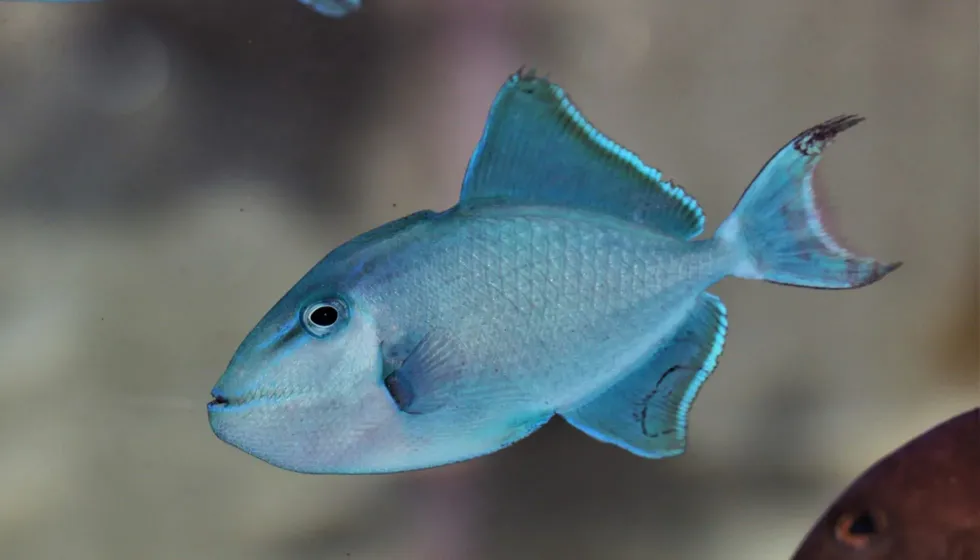Blue triggerfish (Odonus niger) are also widely known as redtoothed triggerfish because of the red teeth visible on their closed jaw. They are widely found fishes in Indo-Pacific waters, that are also found in the Red Sea, and along the Australian Great Barrier Coral Reef.
The blue triggerfish species also lives close to the coasts of India, southern Japan, and east Africa.
It is a fish that has a 'grinning' face, a largely blue-purple body, and prominent red teeth. These marine animals grow to be 8-20 in (20-50 cm) in length and mainly feed on zooplankton and sponges, and are also seen eating carnivorous food like squid, krill, shrimp, and clams.
This fish lives in shallow waters and is protective of its territory and is widely available as pets for sale and for its meat as food. It is the most caught fish in the Indian state of Kerala.
It is known to sometimes bite the hand that is feeding it causing painful bite wounds.
It has a unique method of swimming, like a propeller using its fins. It can swim very fast and live anywhere between 8-20 years.
For more relatable content, check out these Bonito fish facts and rainbow trout facts for kids pages.
Blue Triggerfish Interesting Facts
What type of animal is a blue triggerfish?
The blue trigger-fish is a fish.
What class of animal does a blue triggerfish belong to?
The blue trigger-fish belongs to the Actinopterygii class of animals.
How many blue triggerfish are there in the world?
The exact number of blue triggerfish in the world is unknown.
Where does a blue triggerfish live?
The blue triggerfish lives in oceans and seas, mainly in Indo-Pacific waters. It is also known to inhabit waters of the east coast of Africa, the Great Barrier Coral Reef in Australia, southern Japan, and the Red Sea.
What is a blue triggerfish's habitat?
Blue triggerfish like to inhabit the channels of reefs, and slopes that are long. This fish lives close to the water surface, at depths of 30-100 ft (9-30 m).
These marine animals inhabit waters that have strong currents, and they survive these currents by hiding in between rocks, under reefs, and in crevices. They are also sometimes found living near the coast.
Who do blue triggerfishes live with?
Blue triggerfish live their life in aggregations (groups) and form distinct pairs when mating and breeding.
How long does a blue triggerfish live?
A blue triggerfish's life may last for eight to 20 years.
How do they reproduce?
Blue triggerfish reproduce by spawning and forming distinctive mating pairs between males and females. Their breeding grounds and territories are set up by the male (not the female).
Males and females perform rituals before females lay tens of thousands of eggs in the nests in the reef prepared by the male.
Only females tend to the eggs, but the male displays very aggressive behavior while protecting the eggs in the nest or reef. These marine animals do not spawn in small domestic tanks or aquariums due to their small sizes.
What is their conservation status?
The conservation status of the blue triggerfish is Not Evaluated.
Blue Triggerfish Fun Facts
What do blue triggerfishes look like?
The blue triggerfish is an overall deep purple or blue color. It has markings on its head which are bluish-green.
Its tail lobes and fins also have markings, but they are light blue and they glow. The tail of a blue triggerfish resembles a musical instrument, the lyre.
When looking at a blue triggerfish, their mouths appear to be grinning. Any description of this fish can't miss out the tiny sharp teeth on each jaw which are red.
When its mouth is closed, the blue triggerfish shows two teeth on its upper jaw.
It also has small pectoral fins. They use their dorsal and anal fins to steer themselves.
This fish is able to propel its body in the same fashion as a propeller, which is quite a unique style of swimming for any fish in the ocean.
Blue triggerfish are also able to change colors from light to dark, ranging from bluish-green to blue or light blue to purple, which is dependent on the quality of the water they're in, the type of food they consume, or their mood.

How cute are they?
Blue triggerfish have a certain playful beauty about them and have entertaining characteristics. They change colors to different shades of triggerfish blue depending on their mood. Their mouths appear to give the impression of grinning, and they have noticeable red teeth.
How do they communicate?
Blue trigger fish may communicate with gestures and motions. These fish are also able to produce a grunt-like sound.
How big is a blue triggerfish?
Blue trigger fish are 8-20 in (20-50 cm) long, and 11.8-20 in (30-50 cm) in height, which makes them twice as big as the pumpkinseed sunfish, and three to six times bigger in size than the round goby.
How fast can a blue triggerfish swim?
These fish are capable of achieving high swimming speeds, close to 4.1 l/s (body length per second), meaning a blue trigger fish that is 15 in (38.1 cm) long can cover a distance of close to 61.5 in (156.2 cm) in just 1 second!
How much does a blue triggerfish weigh?
A blue triggerfish weighs 3-10 lb (1.4-4.5 kg).
What are the male and female names of the species?
Female and male blue triggerfish do not have specific names.
What would you call a baby blue triggerfish?
A baby blue triggerfish may be called a 'fry'.
What do they eat?
Blue triggerfish mainly feed on zooplankton, and they also feed on foods such as sponges, krill, clams shrimp, squid, small fish, urchins. In domestic aquariums and tanks, they feed on a varied diet of meaty foods as well as eating frozen foods and algae.
Are they dangerous?
A description of a blue triggerfish will say that it is one of the most peaceful fish, but it tends to become very aggressive towards other fish as it becomes older. If you watch a blue triggerfish in the wild, it can only be considered harmful when it has a nest of eggs to defend.
People have been bitten on the hand while trying to feed blue triggerfishes in aquariums, causing bleeding and painful wounds.
Would they make a good pet?
These fish are often found for sale as juveniles to aquariums. Since their maximum size can be 20 in (50 cm), a minimum tank size of 70-80 gal (318.2-363.7 L) is required, so that they can grow and have room to move.
They are rather peaceful in aquariums with their tank-mates but are known to become aggressive with age. They are not picky eaters in domestic settings or in the wild.
They need to eat twice or thrice a day, with a varied diet of meaty foods and frozen foods, but one should be careful while feeding them, since they can bite, leaving a painful wound that bleeds.
Having corals and reef-like rocks in their aquariums is also important. The temperature doesn't need to be paid much attention to, since a room temperature of 78.8 F (26 C) shall suffice.
Did you know...
Despite their fast speeds and predatory nature, blue triggerfish themselves get preyed on by sharks, groupers, marlins, and other large fish.
The blue triggerfish is also available for sale for its meat, being the most widely caught species of fish in the Indian state of Kerala. It makes for a good cooking fish.
Close relatives of the blue triggerfish which are often up for sale for personal aquariums are the blue-lined triggerfish and the blue-spotted triggerfish. Blue line triggerfish and blue-spotted triggerfish both belong to the family Balistidae. It is also easy to find another close relative, the blue-jaw triggerfish, for sale since it too is widely occurring.
All fish in the Bastilidae family have a lyre-like tail.
What other names does the blue triggerfish have and why?
The blue triggerfish has a variety of names such as redtoothed triggerfish, redfang triggerfish, Niger triggerfish, and redtoothed filefish. It is normally blue or purple-blue in color.
It has these names because of its red teeth on each jaw which look like red fangs. Its scientific name is Odonus niger, hence the name Niger triggerfish, and it also has really rough scaly skin, just like filefish, hence the name redtoothed filefish.
What's unique about the blue triggerfish?
One thing that is unique about the blue triggerfish is their red teeth, two of which are visible on the upper jaw even when their mouths are closed. Also, their faces look like they're grinning.
They are a peaceful species of fish until it comes to protecting their territories or nests. They also tend to become hostile in old age.
They can make grunt-like sounds, and they can swim really fast in a propeller-type fashion, using their fins. They use crevices and spaces between to shield themselves from strong water currents.
Here at Kidadl, we have carefully created lots of interesting family-friendly animal facts for everyone to discover! Learn more about some other fish from our rainbow cichlid interesting facts or green sunfish fun facts for kids pages.
You can even occupy yourself at home by coloring in one of our free printable blue triggerfish coloring pages.









